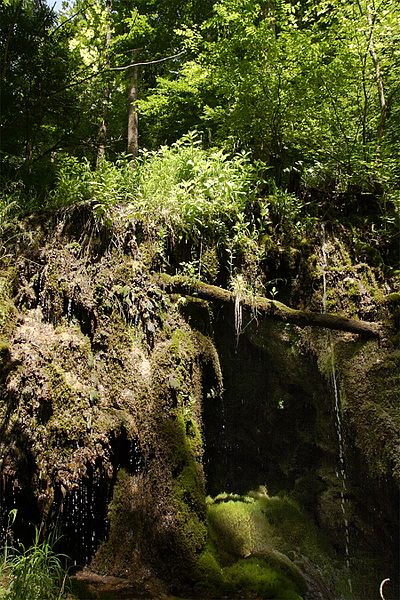File:Kalktuffbarre Fleinsbrunnenbach Erms-Tributar Schwaebische-Alb.jpg

Size of this preview: 400 × 600 pixels. Other resolutions: 160 × 240 pixels | 320 × 480 pixels | 512 × 768 pixels | 1,200 × 1,800 pixels.
Original file (1,200 × 1,800 pixels, file size: 3.12 MB, MIME type: image/jpeg)
File information
Structured data
Captions
Captions
Add a one-line explanation of what this file represents
Summary edit
| DescriptionKalktuffbarre Fleinsbrunnenbach Erms-Tributar Schwaebische-Alb.jpg |
Deutsch: Kalktuff und Primärhöhle am 7-m-Wasserfall (Talverengung und Gefällstufe in den Liegenden Bankkalken, ki4) des sehr kleinen Baches „Fleinsbrunnenbach“ bei Seeburg (Bad Urach), Schwäbische Alb. Der kleine Bach, von der Karstquelle bis zur Mündung in die Erms nur 1,5 km lang, führt – gemessen an der geringen Wassermenge – enorme Mengen an Calciumcarbonat mit sich, die am Wasserfall von Palustriella commutata (Moos) als Kalktuff chemisch ausgefällt werden. Im ersten Stadium ist der Kalktuff eine zähe, wässrig braune Masse, die trocknend, das weiterwachsende Moos umkrusten. So ist hier das Kalktuff-Sediment –vor allem in den wasserreicheren Warmzeiten des Holozäns – angeschwollen und nach vorne gewachsen und hat dabei einen Hohlraum geschaffen, der in fortgeschrittenerem Zustand in eine geschlossene Primärhöhle übergehen würde. Die Forschung zweier geologisch paläontologischer Universitätsinstitute hat den Bach 1993-1995 näher untersucht und festgestellt, dass hier auch kalkbildende Lebewesen (Cyanobakterien) mikrobiologisch Kalktuff-Wachstum verursachen. English: 7-m-waterfall with Palustriella commutata (class of mosses: Bryophyte), calcareous tuff and a growing primary cave of the very tiny rivulet “Fleinsbrunnenbach”, in a valley directly after “Seeburg” (en:Bad Urach), Swabian Alb. The rivulet messures only 1,5 km from karst spring to its flowing into rivulet “Erms”. Fleinsbrunnenbach’s water carries an enormous amount of soluted calcium carbonate, which is chemically precipitated by mosses as seen in the photograph. When freshly sedimented, the calcareous tuff is a washy-brown mass, when dry, it hardens and incrusts the mossplants, which continue to grow. Research done on the Fleinsbrunnenbach in 1993-1995, published in “Sedimentary Geology 126 (1999) 103–124”, even found „organic substrates, particularly cyanobacteria-dominated microbial mats and biofilm”, that are covered by calcium crystals. |
| Date | |
| Source | Own work |
| Author | Ustill |
Licensing edit
This file is licensed under the Creative Commons Attribution-Share Alike 3.0 Germany license.
- You are free:
- to share – to copy, distribute and transmit the work
- to remix – to adapt the work
- Under the following conditions:
- attribution – You must give appropriate credit, provide a link to the license, and indicate if changes were made. You may do so in any reasonable manner, but not in any way that suggests the licensor endorses you or your use.
- share alike – If you remix, transform, or build upon the material, you must distribute your contributions under the same or compatible license as the original.

File history
Click on a date/time to view the file as it appeared at that time.
| Date/Time | Thumbnail | Dimensions | User | Comment | |
|---|---|---|---|---|---|
| current | 12:10, 10 August 2016 |  | 1,200 × 1,800 (3.12 MB) | Ustill (talk | contribs) | User created page with UploadWizard |
You cannot overwrite this file.
File usage on Commons
There are no pages that use this file.
File usage on other wikis
The following other wikis use this file:
- Usage on de.wikipedia.org
Metadata
This file contains additional information such as Exif metadata which may have been added by the digital camera, scanner, or software program used to create or digitize it. If the file has been modified from its original state, some details such as the timestamp may not fully reflect those of the original file. The timestamp is only as accurate as the clock in the camera, and it may be completely wrong.
| Camera manufacturer | Canon |
|---|---|
| Camera model | Canon EOS 350D DIGITAL |
| Author | allwiki@ulrich-tichy.de |
| Copyright holder |
|
| Exposure time | 1/100 sec (0.01) |
| F-number | f/9 |
| ISO speed rating | 200 |
| Date and time of data generation | 14:09, 27 June 2008 |
| Lens focal length | 17 mm |
| Online copyright statement | https://commons.wikimedia.org/wiki/File:Kalktuffbarre_Fleinsbrunnenbach_Erms-Tributar_Schwaebische-Alb.jpg |
| Image title |
|
| City shown | Tübingen |
| Width | 2,304 px |
| Height | 3,456 px |
| Compression scheme | LZW |
| Pixel composition | RGB |
| Orientation | Normal |
| Number of components | 9 |
| Horizontal resolution | 72 dpi |
| Vertical resolution | 72 dpi |
| Data arrangement | chunky format |
| Software used | Adobe Photoshop CS5 Windows |
| File change date and time | 22:34, 6 July 2016 |
| Exif version | 2.21 |
| Date and time of digitizing | 14:09, 27 June 2008 |
| APEX shutter speed | 6.6438598632812 |
| APEX aperture | 6.33984375 |
| APEX exposure bias | −0.66666666666667 |
| Flash | Flash did not fire, compulsory flash suppression |
| Supported Flashpix version | 1 |
| Color space | sRGB |
| Focal plane X resolution | 3,954.2333984375 |
| Focal plane Y resolution | 3,958.7629394531 |
| Focal plane resolution unit | inches |
| Custom image processing | Normal process |
| Exposure mode | Auto bracket |
| White balance | Auto white balance |
| Scene capture type | Standard |
| Rating (out of 5) | 0 |
| Date metadata was last modified | 00:34, 7 July 2016 |
| Unique ID of original document | xmp.did:00B37890FF25E4118BD8E4B5C0218E92 |
| Copyright status | Copyright status not set |